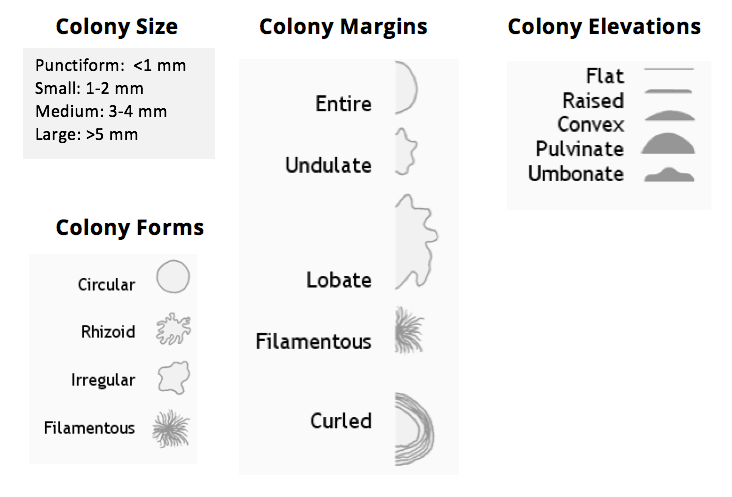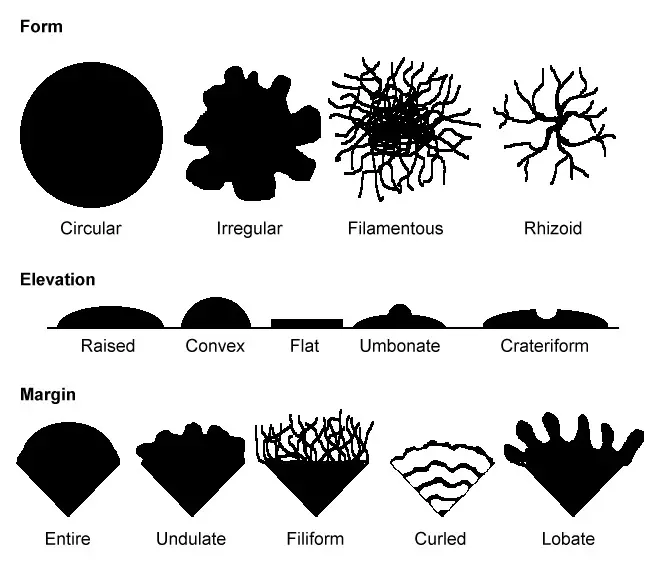Regular entire flat small rough opaque yellow. Bacteria colonies can be distinguished by the various forms in which they occur where the form may be.

Bacteriological Culture Methods Microbiology A Laboratory Experience
See the answer See the answer done loading.

. Surface it pertains to the appearance of the colonys surface such as rough smooth glistening dull or wrinkled. Some colonies are round and smooth others can have wavy edges and a wrinkled appearance. Put some bacteria in the water and spread it out.
The terms used to. Put drop of water on a clean side. The descriptors here are punctiform circular irregular filamentous has individual thin projections or rhizoid has thin branching projectionsSome bacteria produce pigments giving the colony a distinct color.
List four characteristics by. Why would it be important to first isolate a colony when trying to identify an unknown bacterial colony. Based on the surface of the colony it is smooth rough wrinkled glistened and dull.
Size of the colony The size of the colony is determined by its diameter and measured in millimeters. Elevation of the colony is of the following types-Flat. Below is an illustrated guide to the terms we will use.
When an agar plate is inoculated why is the loop sterilized after the initial inoculum is put on. Circular filamentous irregular well as rhizoid. Pure bacterial colonies 1.
The morphology of a colony results from characteristics of the individual. Convex rounded Concave depressedsunken in Flat. Irregular undulate flat pinpoint dull transparent cream.
Define a bacterial colony. Add mordant iodine makes crystal violet stick. Color of the Colony.
Some of these colony characteristics are. Decolaizer ETOH alcohol rise. Irregular filamentous umbonate large glistening opaque cream.
Distinguish between a pure culture and a mixed culture. The organism forms tetrads because of the regular alternation of cell division. All of The following are terms appropriate to describe colony morphology characteristics of bacteria except.
The form of the colony is subdivided into following. Shape of the colony. As we document our discoveries it is absolutely essential that we use common adjectives to describe the physical characteristics of the colonies that our isolates form when cultivated on an agar surface.
It is of the following types-Circular. Colonies that differ in appearance are typically different bacterial strains species or genera. Pulvinate very convex Umbonate raised in the center Target-shaped.
Show transcribed image text. There are an amazing variety of bacterial colony types. However colony morphology is not a reliable way to identify bacteria as many different types of bacteria have similar colony morphology.
Describing Colony Morphology. Add primary stain crystal violet 1 min rinse. The term colony morphology refers to the visible characteristics of a colony.
Up to 24 cash back Colony ElevationsDepressions. Colony morphology of bacteria Shape. The margin of the colony is further divided into.
Heat fix place it through flame 5. Pigments span the entire color spectrum. The edge of a colony can also be helpful characteristic in.
Description of a colonys morphology includes its shape the margins or edges of the colony its color and surface features. Invert and incubate at 37 C until next lab. Shape refers to the overall appearance of the colonies.
Based on the opacity of the colony bacterial colonies are. Edge of the colony can be seen through a magnifier. We can predict the type of the bacteria growing on the plate by the shape of the colony.

Bacterial Colony Morphology Characteristics Examples What Is A Bacterial Colony Video Lesson Transcript Study Com

Colony Morphology Of Bacteria Microbe Online

0 Comments